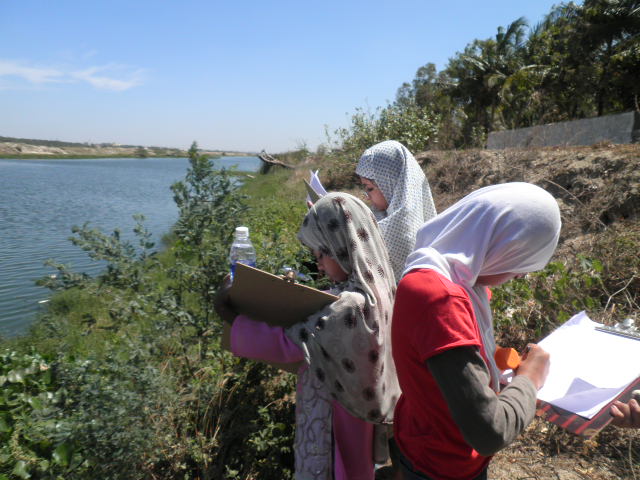
Recap of “Water and Life” (A unit from Class 4 text book) June 15, 2012
Though the kids have formally graduated to Class 5, we hadn’t finished up with the Grade IV curriculum, so are continuing with it.
As school reopened we started with the Water & Life chapter. The kids were not very participative in the discussion of the story, but did recall seeing mosquito larvae and green slimy stuff. I think they knew they were about to go out and do more activities. So we went ahead with the section on “Water in Living Things”. The kids went outside and gathered different leaves and flowers. They also tied plastic bags to the leaves of different plants. They also left some leaves out in the sun at the corner of the school building. We didn’t have the brinjal or cucumber, so we deferred that activity for the next day.
The kids first tried crushing the different leaves and flowers and found “sticky” stuff coming out. Different flowers had different amount of the sticky stuff. They crushed a root – but found it quite dry. They did observe that the leaves and flowers had liquid in them. They went out after an hour (in the hot Chennai sun) and saw the desiccated remains of the leaves. They did say the water had evaporated. They best part was checking out the plastic bags after about an hour and were so excited to find water in it. They weren’t too clear where the water came from initially, but after a discussion concluded that the leaves had “breathed” it out. It took more discussion to figure out why they don’t routinely see the water dripping off the leaves, but only when they tied the plastic bag but eventually they worked out that the plastic bags didn’t let the water evaporate.
On the second day, they constructed a balance with a pencil, a ruler and two empty match boxes. This did take some time, but finally we were able to weigh the flowers and immerse one in water and leave one out beside it. This day we were able to organize the brinjal and cucumber. They were fascinated watching me scoop out the inside of the two vegetables. When I rubbed salt and left it to rest, they were even more curious. Then we set up the next experiment with the flower in the ink.
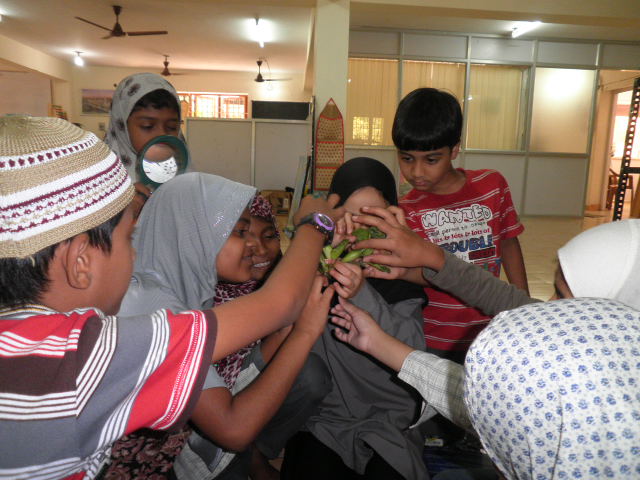
After an hour we saw that the vegetables had quite a bit of water in the scooped out section. “Why”? “Where did the water come from” were the questions from the kids. Finally one said, “the water was in the brinjal and the salt pulled it out”. I left it at that for now. They also tied plastic bags around their hands and hated that. Anything over two minutes was torture, understandably given the Chennai heat and humidity! Some of them took off the bags in about 2 minutes, others stubbornly hung on for 10. The hands were completely wet from sweat.
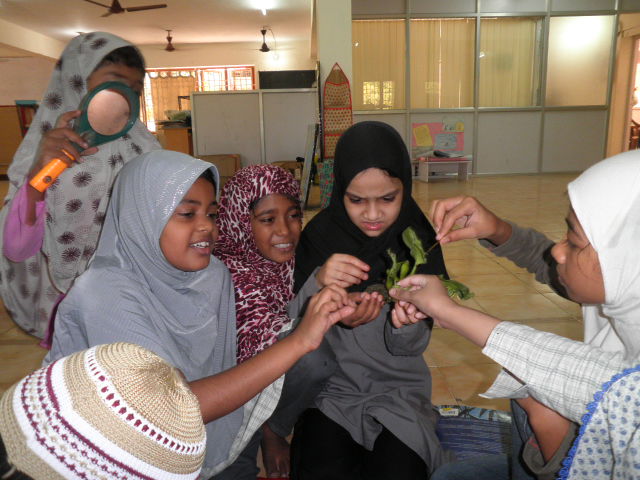
After an hour we saw that the vegetables had quite a bit of water in the scooped out section. “Why”? “Where did the water come from” were the questions from the kids. Finally one said, “the water was in the brinjal and the salt pulled it out”. I left it at that for now. They also tied plastic bags around their hands and hated that. Anything over two minutes was torture, understandably given the Chennai heat and humidity! Some of them took off the bags in about 2 minutes, others stubbornly hung on for 10. The hands were completely wet from sweat.
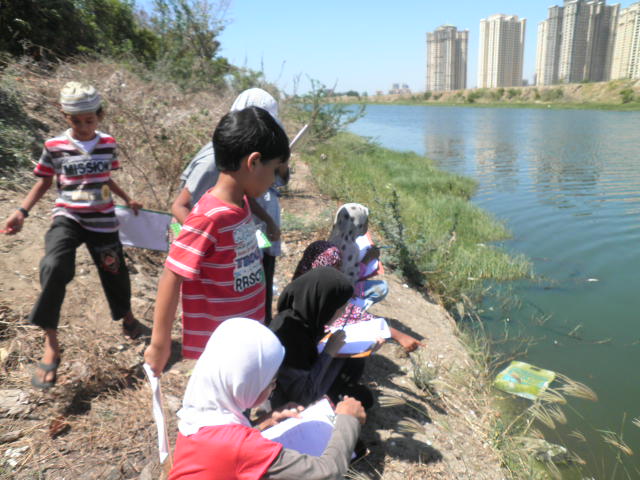
OLYMPUS DIGITAL CAMERA
The children observed and recorded all the living things they saw – from herons, ducks, fish, spiders, ants, water insects, dead fish, water reeds, hyacinths, flycatchers, fork tail birds, grass, thorns, algae. They drew wonderful sketches and wrote descriptions of what they saw.

A sample of the water was taken and the children were surprised at how it was teeming with life – bugs, worms, and whatnot! One thing that intrigued them was little black dots whizzing through the water! I don’t know what they were. Can anyone help here? The hyacinth sample we brought back started wilting very soon, even before we reached the school. The kids saw a little spider in its roots and bugs. We also brought back a water rush sample – which burst the next day and the classroom was full of white fluffy seeds!
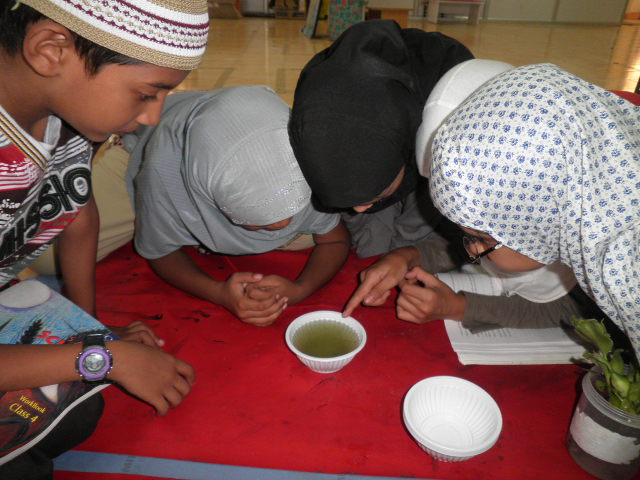
On returning, the kids checked out the water though it smelled awful. They did observe that the water looked so clean until we saw the sample in the container. Another sample of tap water was taken and the two samples are being observed daily. Both are evaporating, and both are getting dirtier! But the canal water is really stinking by now (it played host to the poor hyacinth for some time also).
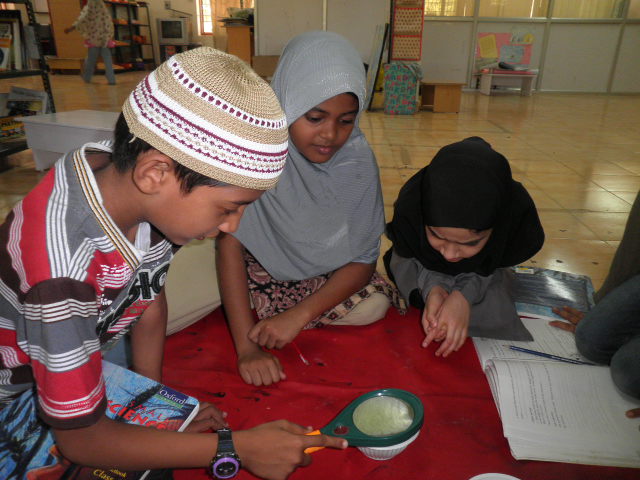
The kids weighed the two flowers from the previous day and found that 9 drops of water had to be added to the dried flower the equalize the weight. Nusaibah said the dried flower lost 5 drops of water. When asked why, she said “the other flower must have gained 5 drops of water being in the water.”! We observed faint blue lines around the petals of the flower soaked in an ink solution and saw how the solution had made its way up the stem (by splitting the stem to see what’s inside).
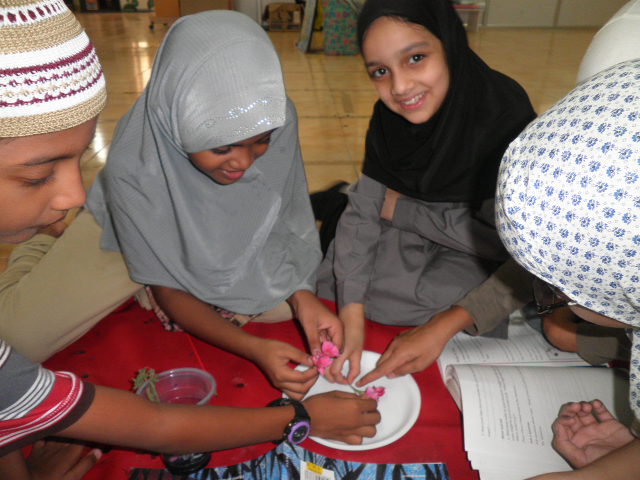
The next class was a discussion on the microbes. I think they are having a hard time getting this – because microbes are not something they can hold/see. The understanding is quite bookish.
In terms of the workbook exercises, the kids struggled to say how they knew that water exists in the root, stem, flower etc. Answers like “roots suck up the water” and “leaves make food” were trotted out. Only when I pushed them, they remembered that they had crushed the leaves etc. and observed the liquid coming out. Another question they didn’t get immediately was the one asking them to draw pictures of a plant with too little water, just enough water and too much water. They drew different kinds of plants for each – a cactus for the first, a tree for the next and a water hyacinth for the last. Maybe the wording can be made more explicit? They were content to simply sketch stuff for the exercises calling for “draw, label, describe”, but when pushed started trying to write descriptions. One kid, Safa, brought detergent as an example of something non living with needs water, but the others were quite bowled over by the question. Once they saw what Safa had brought, they also brought stuff the next day.
Aneesa Jamal
Correspondent
Al Qamar Academy



